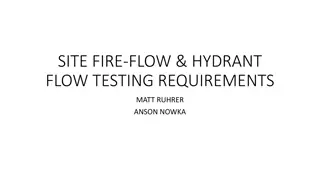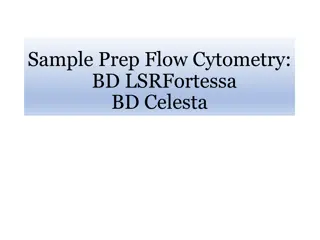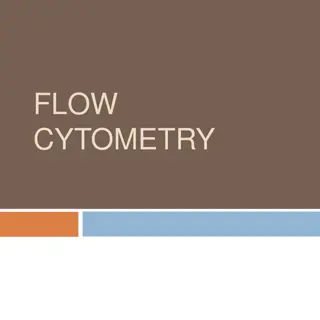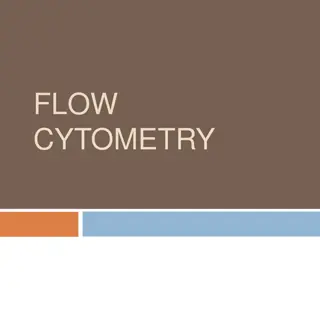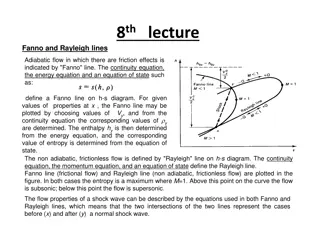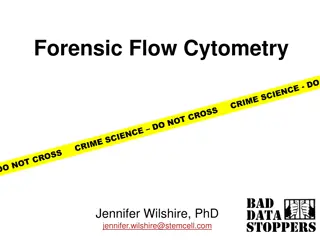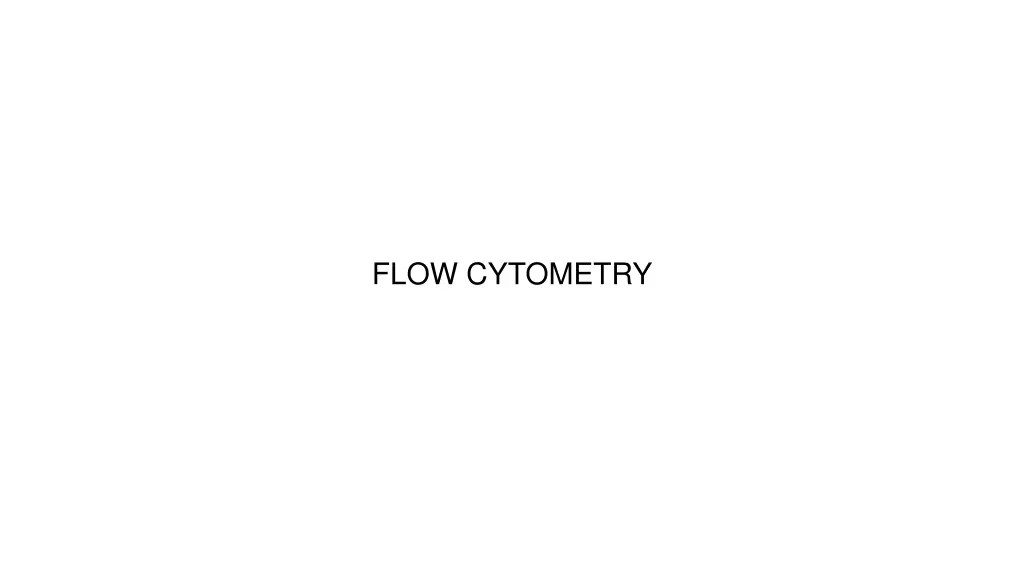
Understanding Flow Cytometry: Principles, Applications & Instrumentation
Explore the world of flow cytometry, a process for measuring physical and chemical components of cells and particles. Learn about its principles, instrumentation, and various applications in fields like hematology, immunology, and oncology. Discover how fluorescence emission systems help classify particles based on size, shape, and more.
Download Presentation

Please find below an Image/Link to download the presentation.
The content on the website is provided AS IS for your information and personal use only. It may not be sold, licensed, or shared on other websites without obtaining consent from the author. If you encounter any issues during the download, it is possible that the publisher has removed the file from their server.
You are allowed to download the files provided on this website for personal or commercial use, subject to the condition that they are used lawfully. All files are the property of their respective owners.
The content on the website is provided AS IS for your information and personal use only. It may not be sold, licensed, or shared on other websites without obtaining consent from the author.
E N D
Presentation Transcript
CONTENTS Definition Principle Instrumentation Application
Cytometry Measurements of physical and chemical components FLOW CYTOMETRY: process where such measurements are made while cells or particles pass, preferably in single file, through the measuring apparatus in a fluid stream.
Principle Based on the measurement of light scattered by particles and fluorescene observed when these particles are passed in stream through laser beam
Cells / molecules labelled with specific fluorescent labels 1. Beta phycoerthrin 2. Fluorescien isothiocyanate 3. Rhodamine 6 G 4. Other dye labelled antibodies
Most of FC incorporates 2 or more fluorescence emission system multiple fluorescent labels can be used By this manner particles classified according to 1. Size 2. Shape 3. Type of light scattering 4. Fluorescent properties
Instrumentation 1. Fluidic system 2. Optical system 3. Electronic system
Most commercial FC uses 2 or more laser light source Eg; LSR II (BD biosciences, Rockville Marryland)--- with 7 lasers 1. UV 355nm 2. Voilet 405nm 3. Blue 488nm 4. Green 532nm 5. Yellow 594nm 6. Red 638nm 7. Infra red 785nm Simultaneously measure 18 emission spectra
Applications Able to measure multiple parameters 1. Cell size 2. Granularity 3. DNA content 4. RNA content 5. Chromatin structure 6. Antigens 7. Total protein content 8. Cell receptors 9. Membrane potential 10. Ca ion conc as the function of pH
Used in hematology, immunology, oncology, microbiology, virology. Potential application for development of sensitive laser induced fluro immunoassay FC combines with microspheres used as solid support for conventional Immunoassays, Affinity assays and DNA hybridization assay
CONTENTS Definition Principle Materials used Application
Definition Separation based on the size and shape which utilizes the molecular sieve properties of variety porous materials PRINCIPLE: Based on the column of gel particles is in equilibrium with a suitable mobile phase for the molecules to be seperated
Mobile phase absorbed by a gel available for an analyte dependent upon porosity of gel particle & size of analyte This distribution of analyte in a column is determined by volume of mobile phase Kd (distribution coefficient) for large particle is 0 Kd is 1 for small particles Kd varies from 0-10 for intermediate particles
Materials commonly used 1. Cross linked dextrans 2. 3. 4. 5. Agarose Polyacrylamide Polyacrylolylmorphine Polystyrene
Applications 1. Purification 2. Relative molecular mass determination 3. Solution concentration 4. Desalting 5. Protein binding studies
CONTENTS Columns Pumps Application of sample Detectors Application
Has emerged most popular , powerful and versatile form of chromatography. COLUMNS: Made of stainless steel TYPES: 1. Straight columns 2. Microbore columns 3. Open tubular columns 4. Preparative columns
MATRICES AND STAIONARY PHASE Three forms of column packing materials are used. 1. Microporous support 2. Pellicular support 3. Bonded phase
Column packing HPLC column can be purchased Majority priority in packing of column is to obtain uniform bed of materials with no cracks / channels Widely used technique for column packing is High pressure slurrying technique
Mobile phase and Pumps Depend on the type of separation achieved Isocratic separation Solvents used in HPLC should be free from impurities Pumping system for delivery of mobile phase is one of the most important features in HPLC Constant displacement pumps Reciprocating pumps
Application of sample Correct application of sample to HPLC column is important factor in achieving successful separation Two methods generally used 1. Use of microsyringe 2. Loop injection
Detectors 1. Ultra violet visible spectrometry 2. Scanning wavelength detectors 3. Absorbance detector 4. Fluorescence detector 5. Electrochemical detector 6. Refractive index detector 7. MS 8. Conductivity detector
Ultra violet visible spectrometry Capable of measuring absorbance down to 190nm Scanning wavelength detectors: Have facility to record the complete absorption spectrum of each analyte thus aiding identification
Fluorescence detector PRINCIPLE: measures the ability of chemical to absorb and reemit light through fluorescence
Absorbance detector PRINCIPLE: measures the absorbance of light at a given wavelength
Electrochemical detector PRINCIPLE: measures the current as the result of chemical oxidation or reduction
Conductivity detector--measures the change in the conductivity of MP as ions elute from the column. REFRACTIVE INDEX DETECTOR: measures change in refractive index of MP as compounds elute from the column








